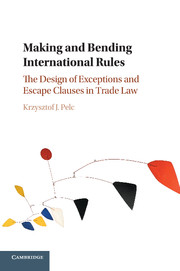Book contents
- Frontmatter
- Dedication
- Contents
- List of Tables
- Acknowledgments
- 1 The “Architectural Challenge” of International Rules
- 2 A Theory of the Design of Flexibility
- 3 A Brief Intellectual History of Flexibility in Law
- 4 The Twin GATT Exceptions: Fears and Solutions
- 5 The Evolving Design of Flexibility
- 6 The Bad News
- 7 The Good News
- 8 The Great Recession and Beyond
- Bibliography
- Index
2 - A Theory of the Design of Flexibility
Published online by Cambridge University Press: 05 September 2016
- Frontmatter
- Dedication
- Contents
- List of Tables
- Acknowledgments
- 1 The “Architectural Challenge” of International Rules
- 2 A Theory of the Design of Flexibility
- 3 A Brief Intellectual History of Flexibility in Law
- 4 The Twin GATT Exceptions: Fears and Solutions
- 5 The Evolving Design of Flexibility
- 6 The Bad News
- 7 The Good News
- 8 The Great Recession and Beyond
- Bibliography
- Index
Summary
This chapter develops a theory of institutional flexibility that seeks to account for two phenomena. The first is the design of rules covering flexibility; the second is the behavior of states invoking flexibility provisions. In doing so, this chapter seeks to address the regime's architectural challenge: how can flexibility clauses be designed to allow countries temporary reprieve when needed, while precluding abuse?
The architectural challenge emerges from the attempt to balance the benefits and the costs of flexibility. The benefits are well established. The costs are less often discussed, and include the unpredictability that results from governments having the ability to suspend their obligations. Governments’ seek to manage such unpredictability while retaining the option to escape under hard times.
I discuss the main existing explanation for the design of flexibility, and argue that it is at odds with the domestic factors that lead countries to sign agreements in the first place. The remainder of the theory formulates expectations over state behavior in the absence of constraints on flexibility, which I argue obeys the same logic that drives the design of rules in the first place.
THE DEBATE OVER FLEXIBILITY IN INTERNATIONAL TREATIES
Country negotiators are not alone in disagreeing about the design of flexibility in trade. It is also the source of much debate among scholars. In important respects, the disagreements over the design of rules can be brought down to a debate about a prior question: why do countries tie their hands through international trade agreements in the first place?
Why Do Countries Sign Trade Agreements?
This question goes beyond the scope of this book, and much of the early institutional literature has been dedicated to answering it. Yet expectations over flexibility hinge on underlying beliefs about why countries commit to rules in the first place. Modify that initial premise (by considering instead another type of economic agreement, such as investment treaties), and expectations over the design of flexibility change accordingly. The argument I put forward is premised on the importance of the domestic political drivers of countries’ willingness to make international commitments.
Information
- Type
- Chapter
- Information
- Making and Bending International RulesThe Design of Exceptions and Escape Clauses in Trade Law, pp. 18 - 42Publisher: Cambridge University PressPrint publication year: 2016
